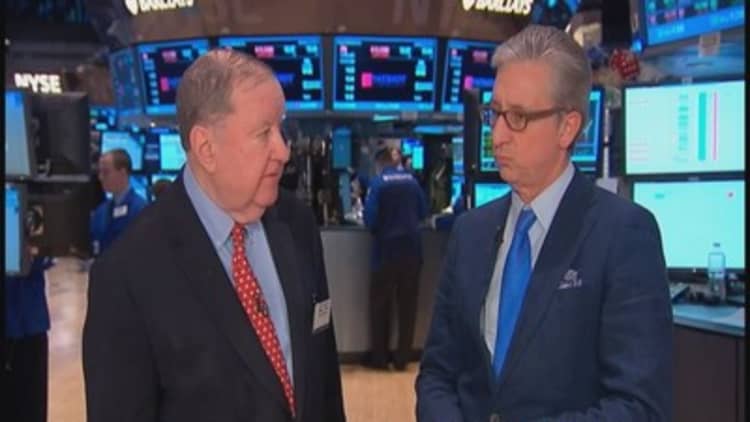
U.S. stocks jumped Friday to close higher for a first session in six, while tallying a third weekly drop, as energy led gains with U.S. crude rising and as investors considered a mixed bag of economic reports.
"A relief rally is probably what we're having here, with some of the very beaten down sectors, like energy, looking better today and performing well," Paul Nolte, senior vice president, portfolio manager at Kingsview Asset Management, said.
The stock market offered little or no reaction to a series of apparently untrue tweets sent by hackers on the New York Post Twitter account.
"The market is in no way reacting to this," Art Hogan, chief market strategist at Wunderlich Securities, said of errant tweets, which were deleted within minutes of being posted.
"The market is reacting to economic data that is more good than bad, to energy being up 3 and 4 percent, and before a long weekend, when investors don't tend to be bearish," Hogan said.
Intel steadied after the maker of computer chips reported quarterly results; Goldman Sachs Group fell after the investment bank reported a 7 percent decline in quarterly profit, and PNC Financial Services Group rose after the regional bank reported solid fourth-quarter results.
Results from the banking sector had "those more tied to Wall Street, like JPMorgan, that have bigger trading desks, not doing so well. Those not tied to Wall Street, like Wells Fargo and PNC, did okay, so traditional banking is doing alright, it's the trading desks making or breaking it for banks," Nolte said.
The University of Michigan's preliminary consumer sentiment index from a final 93.6 December reading.
The consumer-price index , with he cost of living falling by the most in half a dozen years following a 0.3 percent fall the month before, the Labor Department reported.
A third report had in December, up 0.3 percent versus a 1.3 percent increase in output in November.
Nolte, however, found the data disappointing. "The one that stuck out were the industrial production numbers, which dovetails well with the very poor retail-sales number, and may point to additional weakness in the U.S. economy," Nolte said.
The sentiment reading was "nice, but I would lean heavier on retail sales, as they tell me what the consumer is doing, not what the consumer is saying," Nolte said.
Mark Luschini, chief investment strategist at Janney Montgomery Scott, had a differing take.
While not indicating contraction, softer economic reports during the last few weeks have had investors "conjuring up images of the U.S. succumbing to weak growth abroad," Luschini said.
Friday's "exceptionally strong and important" confidence reading helped foster the notion that "we can ward off those external conditions," he added.
Worry that "global economic growth is going to decelerate" is underlying issue driving market volatility, Scott Wren, senior equity strategist at Wells Fargo Investment Institute, said.
Major U.S. Indexes
Down 1.3 percent from the week-ago close, the Dow Jones Industrial Average rose 190.86 points, or 1.1 percent, to 17,511.57, with Home Depot and Exxon Mobil leading blue-chip gains that extended to 27 of 30 components.
The added 26.75 points, or 1.3 percent, to 2,019.42, with energy leading gains that extended to all 10 of its major industry groups, and leaving it with a weekly fall of 1.2 percent.
The CBOE Volatility Index, a measure of investor uncertainty, fell 6.4 percent to 20.95.
The Nasdaq gained 63.56 points, or 1.4 percent, to 4,634.38, off 1.5 percent for the week.
For every share falling, roughly four rose on the New York Stock Exchange, where 976 million shares traded. Composite volume surpassed 4 billion.
Crude oil for February delivery rose $2.44, or 5.3 percent, to $48.69 a barrel and gold futures added $12.10, or 0.9 percent, to $1,276.90 an ounce on the New York Mercantile Exchange.
The U.S. dollar rose against the currencies of major U.S. trading partners and the yield on the 10-year Treasury note used to figure mortgage rates and other consumer loans rose 11 basis points to 1.8268 percent.
On Thursday, U.S. stocks fell for a fifth day, with the S&P 500 finishing below 2,000 for the first time in a month, as crude prices fell, large U.S. banks reporting disappointing results, and Switzerland's central bank unexpectedly gave up its minimum exchange rate.
Read MoreStocks decline for 5th day as oil falls, banks miss


